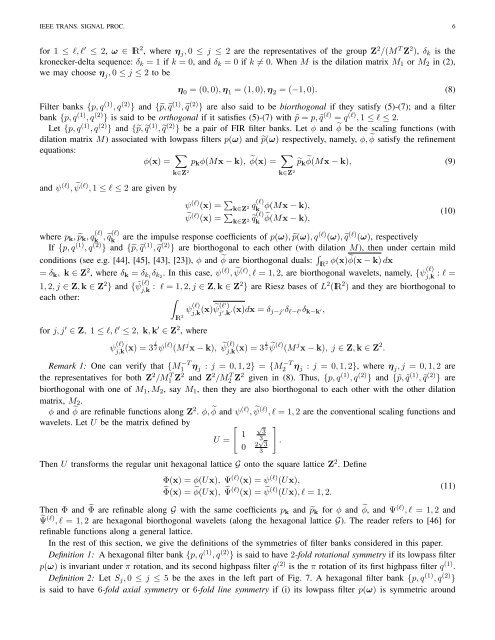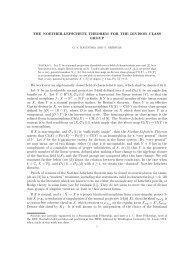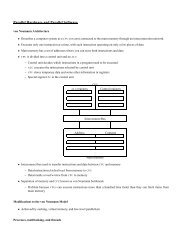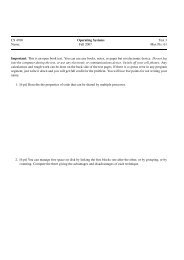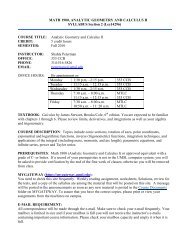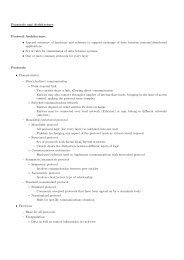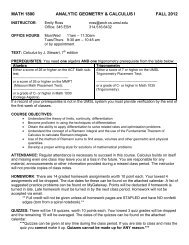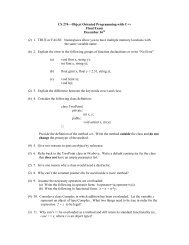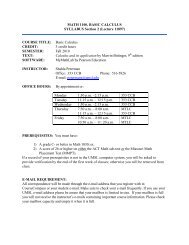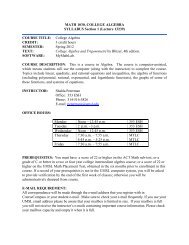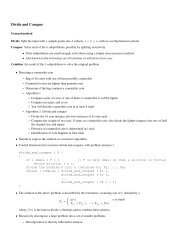here - UMSL : Mathematics and Computer Science - University of ...
here - UMSL : Mathematics and Computer Science - University of ...
here - UMSL : Mathematics and Computer Science - University of ...
Create successful ePaper yourself
Turn your PDF publications into a flip-book with our unique Google optimized e-Paper software.
IEEE TRANS. SIGNAL PROC. 6<br />
for 1 ≤ l, l ′ ≤ 2, ω ∈ IR 2 , w<strong>here</strong> η j , 0 ≤ j ≤ 2 are the representatives <strong>of</strong> the group Z 2 /(M T Z 2 ), δ k is the<br />
kronecker-delta sequence: δ k = 1 if k = 0, <strong>and</strong> δ k = 0 if k ≠ 0. When M is the dilation matrix M 1 or M 2 in (2),<br />
we may choose η j , 0 ≤ j ≤ 2 to be<br />
η 0 = (0, 0), η 1 = (1, 0), η 2 = (−1, 0). (8)<br />
Filter banks {p, q (1) , q (2) } <strong>and</strong> {˜p, ˜q (1) , ˜q (2) } are also said to be biorthogonal if they satisfy (5)-(7); <strong>and</strong> a filter<br />
bank {p, q (1) , q (2) } is said to be orthogonal if it satisfies (5)-(7) with ˜p = p, ˜q (l) = q (l) , 1 ≤ l ≤ 2.<br />
Let {p, q (1) , q (2) } <strong>and</strong> {˜p, ˜q (1) , ˜q (2) } be a pair <strong>of</strong> FIR filter banks. Let φ <strong>and</strong> ˜φ be the scaling functions (with<br />
dilation matrix M) associated with lowpass filters p(ω) <strong>and</strong> ˜p(ω) respectively, namely, φ, ˜φ satisfy the refinement<br />
equations:<br />
φ(x) = ∑ k∈Z 2 p k φ(Mx − k), ˜φ(x) = ∑ k∈Z 2 ˜p k ˜φ(Mx − k), (9)<br />
<strong>and</strong> ψ (l) , ˜ψ (l) , 1 ≤ l ≤ 2 are given by<br />
ψ (l) (x) = ∑ k∈Z 2 q(l) k<br />
φ(Mx − k),<br />
˜ψ (l) (x) = ∑ k∈Z 2 ˜q(l) ˜φ(Mx k<br />
− k),<br />
w<strong>here</strong> p k , ˜p k , q (l)<br />
k , ˜q(l) k<br />
are the impulse response coefficients <strong>of</strong> p(ω), ˜p(ω), q(l) (ω), ˜q (l) (ω), respectively<br />
If {p, q (1) , q (2) } <strong>and</strong> {˜p, ˜q (1) , ˜q (2) } are biorthogonal to each other (with dilation M), then under certain mild<br />
conditions (see e.g. [44], [45], [43], [23]), φ <strong>and</strong> ˜φ are biorthogonal duals: ∫ IR φ(x)˜φ(x − k) dx<br />
2<br />
= δ k , k ∈ Z 2 , w<strong>here</strong> δ k = δ k1 δ k2 . In this case, ψ (l) , ˜ψ (l) , l = 1, 2, are biorthogonal wavelets, namely, {ψ (l)<br />
j,k : l =<br />
1, 2, j ∈ Z, k ∈ Z 2 (l)<br />
} <strong>and</strong> { ˜ψ<br />
j,k : l = 1, 2, j ∈ Z, k ∈ Z2 } are Riesz bases <strong>of</strong> L 2 (IR 2 ) <strong>and</strong> they are biorthogonal to<br />
each other:<br />
∫<br />
ψ (l)<br />
j,k (x) ˜ψ (l′ )<br />
j ′ ,k<br />
(x)dx = δ ′ j−j ′δ l−l ′δ k−k ′,<br />
IR 2<br />
for j, j ′ ∈ Z, 1 ≤ l, l ′ ≤ 2, k, k ′ ∈ Z 2 , w<strong>here</strong><br />
ψ (l)<br />
j,k (x) = 3 j 2 ψ (l) (M j x − k), ˜ψ(l) j,k (x) = 3 j 2 ˜ψ(l) (M j x − k), j ∈ Z, k ∈ Z 2 .<br />
Remark 1: One can verify that {M1 −T η j : j = 0, 1, 2} = {M2 −T η j : j = 0, 1, 2}, w<strong>here</strong> η j , j = 0, 1, 2 are<br />
the representatives for both Z 2 /M1 T Z2 <strong>and</strong> Z 2 /M2 T Z2 given in (8). Thus, {p, q (1) , q (2) } <strong>and</strong> {˜p, ˜q (1) , ˜q (2) } are<br />
biorthogonal with one <strong>of</strong> M 1 , M 2 , say M 1 , then they are also biorthogonal to each other with the other dilation<br />
matrix, M 2 .<br />
φ <strong>and</strong> ˜φ are refinable functions along Z 2 . φ, ˜φ <strong>and</strong> ψ (l) , ˜ψ (l) , l = 1, 2 are the conventional scaling functions <strong>and</strong><br />
wavelets. Let U be the matrix defined by [ √ ]<br />
1 3<br />
Then U transforms the regular unit hexagonal lattice G onto the square lattice Z 2 . Define<br />
U =<br />
0<br />
3<br />
2 √ 3<br />
3<br />
Φ(x) = φ(Ux), Ψ (l) (x) = ψ (l) (Ux),<br />
˜Φ(x) = ˜φ(Ux), ˜Ψ (l) (x) = ˜ψ (l) (Ux), l = 1, 2.<br />
Then Φ <strong>and</strong> ˜Φ are refinable along G with the same coefficients p k <strong>and</strong> ˜p k for φ <strong>and</strong> ˜φ, <strong>and</strong> Ψ (l) , l = 1, 2 <strong>and</strong><br />
˜Ψ (l) , l = 1, 2 are hexagonal biorthogonal wavelets (along the hexagonal lattice G). The reader refers to [46] for<br />
refinable functions along a general lattice.<br />
In the rest <strong>of</strong> this section, we give the definitions <strong>of</strong> the symmetries <strong>of</strong> filter banks considered in this paper.<br />
Definition 1: A hexagonal filter bank {p, q (1) , q (2) } is said to have 2-fold rotational symmetry if its lowpass filter<br />
p(ω) is invariant under π rotation, <strong>and</strong> its second highpass filter q (2) is the π rotation <strong>of</strong> its first highpass filter q (1) .<br />
Definition 2: Let S j , 0 ≤ j ≤ 5 be the axes in the left part <strong>of</strong> Fig. 7. A hexagonal filter bank {p, q (1) , q (2) }<br />
is said to have 6-fold axial symmetry or 6-fold line symmetry if (i) its lowpass filter p(ω) is symmetric around<br />
.<br />
(10)<br />
(11)


